The average toilet lasts more than 40 years with only a minimal amount of maintenance. There are times, however, when water leaks from under the toilet and spills onto the floor, causing severe damage.
It can be stressful to discover that your toilet is leaking, especially if the leak is causing other parts of your home to become damaged.
It is likely that you have a leaking toilet in your basement due to the fact that water always flows downward. You can try replacing the wax ring. In most cases, this will resolve the leak.
If the toilet leaks into the basement, what should be done next depends on what caused it. The problem can easily be diagnosed and fixed, even if you’ve never done any plumbing work before.
Why Is The Toilet Leaking From The Base?
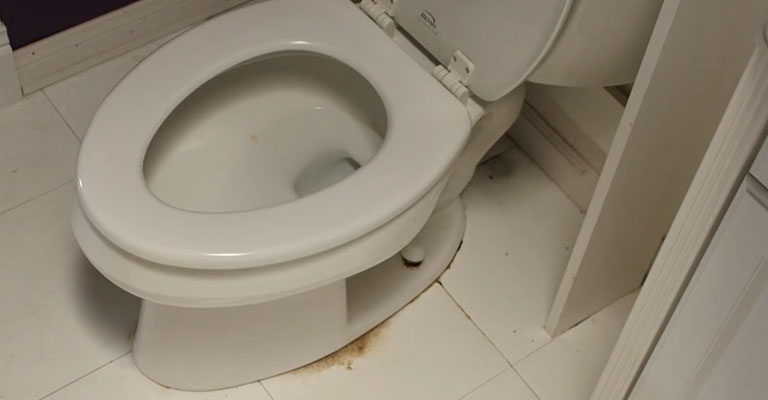
The toilet base may leak if water leaks downward when you flush the toilet or into the basement.
The problem often stems from a cracked base or connector pipe, but it could also stem from the toilet’s wax seal. If the seal is faulty, it is relatively easy to fix, but anything more will require professional help.
Toilets often have water near them for three reasons.
- Issues with wax rings.
- Cracked base.
- Too cold water supply causing condensation on the tank.
Faulty seals under the toilet usually cause leaks in toilets. Installing a new flexible water-supply tube and a wax gasket will make your toilet and closet flange watertight.
There is a good chance the wax seal at the toilet’s base has failed if there is water pooling around its base. There are times, however, when the problem lies elsewhere. Towel off the toilet after soaking up the water with a sponge.
When you see a new puddle appearing on the floor, you should check to see if it’s coming from the underside of the toilet and not from a loose supply tube, faulty shutoff valve, cracked tank, or sweaty bowl.
Additionally, there are the following factors:
1. A Damaged Toilet Will Leak
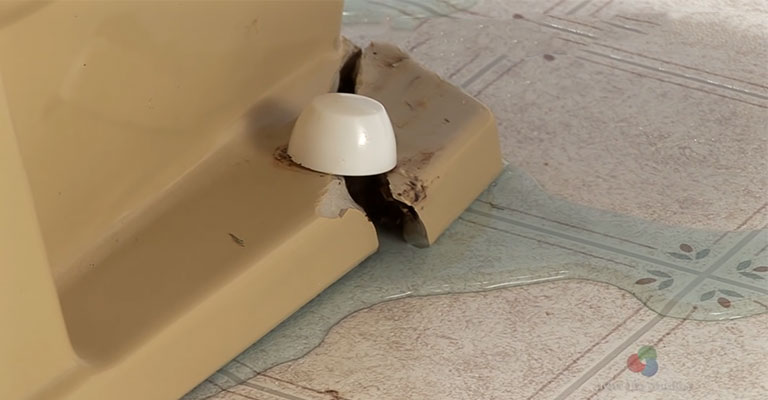
There is also a possibility that the leak is coming from the toilet. Puddles can form on the floor due to cracks in the tank or bowl, causing your basement to flood.
Look for cracks at the base of your toilet’s back. The connector pipe or porcelain itself may have cracked if water only leaks upon flushing. It will be necessary to replace the toilet if it is damaged.
If the connector pipe is malfunctioning, you’ll probably need a professional to fix it. Likewise, if it is cracked or the adhesive that seals the pipe components together has worn off, it might require replacement.
Unfortunately, there are complex fixes to both of these issues that you might not be able to handle on your own.
2. Leaking Water Supply from the Pipe
There is a hose connected to your toilet via bolts and gaskets that connect it to the water supply. You can usually find this supply line behind the toilet, either on the wall or on the floor. The shutoff valve is located on this line.
Leaks can occur at the valve and connectors. In some cases, tightening the connection points can solve a leak.
3. Damaged Bolts or Gaskets Will Cause Leaks
Two bolts with rubber gaskets connect the toilet bowl and the toilet tank. These rubber gaskets can become brittle and fall apart over time. Furthermore, the bolts loosening can lead to water leaking between the tank and the bowl.
There’s also the possibility of brittle rubber gaskets letting water in and in addition, rusting of the metal damages the bolts when it is exposed to water.
It is possible that they may not hold the toilet in place properly or sit in the right position. Therefore, for rusted bolts not to develop a leak in the future, they must be replaced, even if there is no leak currently.
4. The Wear and Tear of Seals Allow Water to Leak
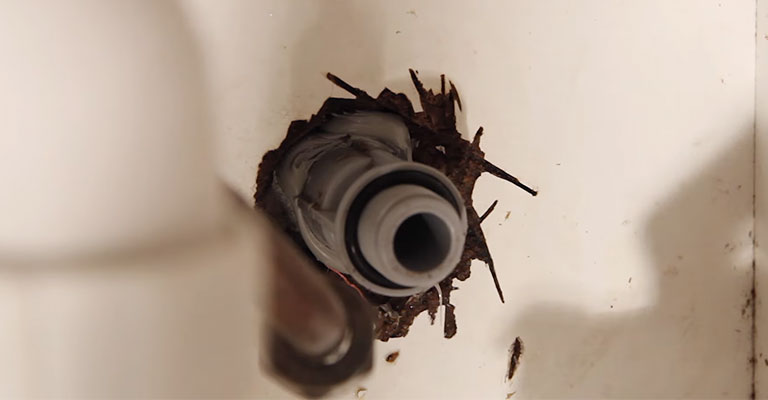
It could be indicative of a bad seal on your toilet if water pools at the base. The wastewater from your toilet is conveyed to your sewage system by a waste pipe.
Toilet flanges are connected to this pipe by wax seals that are located in between the flange and the toilet.
Four points are typically bolted down on the toilet flange. The wax seal ring creates a watertight seal between the toilet flange and the floor.
Toilet Leaking Into Basement? Here Is How You Can Fix It
If the wax ring needs to be replaced, you can do that. You should be able to fix the leak that you describe with that. It is essentially a wax gasket that seals the area between the porcelain bowl and the floor flange.
As this gasket ages/moves/etc., it will eventually leak when flushed, resulting in a big mess. There is not much to it when it comes to replacing the ring:
Step 1: Remove The Toilet
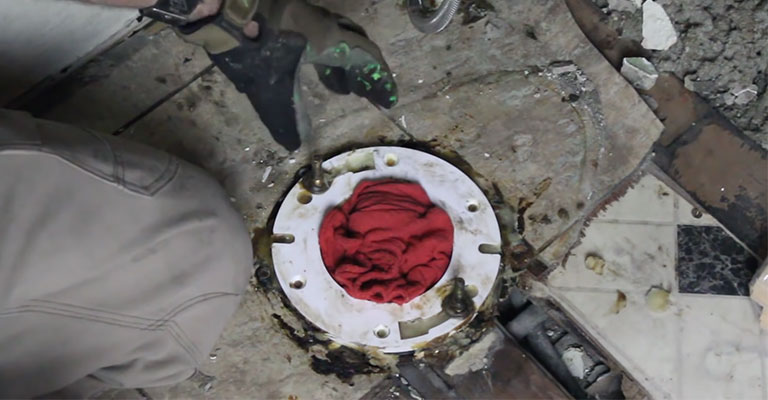
- Disconnect the bowl from the water source
- Turn off the water shutoff valve by unplugging the flexible water pipe
- Use a plunger to get rid of the remaining water after flushing the toilet (hold down the handle and push the water down the toilet)
- Remove the bolts on either side of the bowl. You may have to hacksaw these off if they are corroded or completely stuck.
- Using a small rocking motion, gently release the seal in the bowl and then take the toilet away from the drain.
- Turn the toilet bowl upside down to expose the toilet’s bottom seal.
Step 2: Install A New Wax Ring
- Use a putty knife to scrape away the old wax material from the bowl and flange (a plastic funnel may also be present).
- (The rounded portion of your new wax ring should be facing upwards towards the bowl.)
- Install the replacement bolts on the flange in the same position as the bolts you cut from the flange with a hacksaw.
Step 3: Reinstall The Toilet
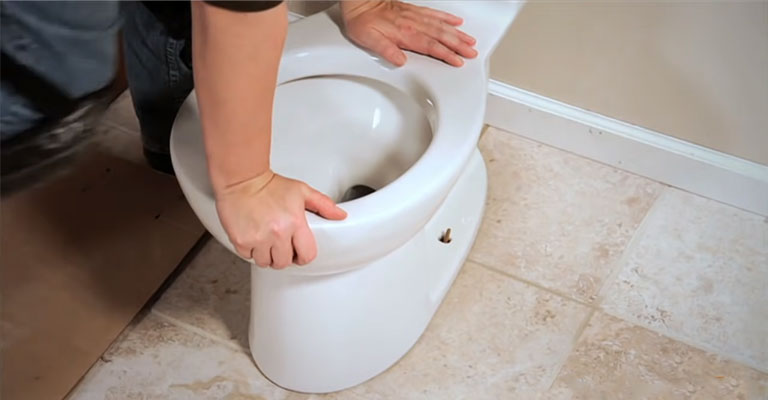
- Place the wax ring inside the toilet bowl and lift it up and thread the bolts through the holes. (Turn the toilet back up to its final position when you are ready).
- Sit on the bowl to secure it in place once it has reached its final resting position. The wax ring should be squeezed gently by rocking back and forth.
- As soon as you reach the bottom of the toilet, make sure that the entire base is on the ground.
- Make sure the washer and bolts holding down the toilet are reinstalled.
- It is important to tighten these bolts carefully (do them a little at a time, switching between the two as you go). Flanges and bowls should not be broken.
- Ensure the bolts are adjusted to the correct length with a hacksaw. Over the bolts, replace the plastic caps.
- Replace the shutoff valve with a new one
- Activate the water system
Additional Steps To Repair A Toilet That Is Leaking
Most of the time, repairing a leaking toilet requires only a few tools. Identifying the leak source will allow you to determine whether you can complete the project on your own.
It is necessary to consult a professional if you lack confidence. Most home supply stores have the materials you need to fix a leaking toilet.
However, if the leak comes from a bolt or washer, a gasket, a toilet flange, or a wax seal ring, you will need to replace it.
Do not repair a toilet with a crack in the bowl or tank that causes a leak. It is mandatory to replace toilets that are cracked.
Step 1: The Water Valve Needs To Be Shut Off
The water supply should be turned off. A hose comes from either the floor or the wall to the water supply valve behind your toilet. Depending on your water source, the main valve may also need to be shut off.
Step 2: Drain The Toilet Bowl And The Tank Of All Water
Get the toilet as empty as you can. Ensure the tank and waste pipe are filled with water by flushing the toilet. The water will keep flowing when you hold down the handle until it runs out.
It’s likely that the tank and the bowl still have some water in them. Protect yourself by wearing gloves and soaking up the water with a sponge or rag.
Put the sponge or rag in a bucket or other container where it can be disposed of safely.
Step 3: Make The Necessary Repairs
These are the possible repairs you may find and need to repair. Listed are the problems and the repairs.
- Remove the tank and scrape off the old seal if the seal is busted. Ensure no remnants of the old seal are present when replacing the damaged one. To avoid having to remove the tank again, put the tank back and replace the bolts with new ones.
- Remove the four bolts and the toilet if the seal is busted on the floor. Replacing an old seal requires scraping it off and reapplying a new seal. Instead, bolt the toilet down again and place it in place.
- Water leaking from rusted tank bolts can be fixed by replacing them.
- Remove the damaged pipe from the water supply and replace it with a new one if it leaks. Rings and bolts are holding all connections together. Wrenches may be needed to disconnect older models.
Step 4: Test the Toilet for Additional Leakage
Restart the water supply once the problem has been resolved. Ensure that the toilet is flushed after the tank has filled up and that no leaks are left behind.
Step 5: Clean Up the Water Damage
Depending on the severity of the water damage, this step may be necessary. It may be required to use mops, buckets, or towels. Complete dryness would be achieved with dehumidifiers.
The Age-old Caulk Question
Caulking around the base of a toilet has long been a debate in the plumbing world. In most cases, plumbers don’t do this because they’re concerned about caulking masking leaks.
However, to prevent bacteria from growing in the joint, builders must caulk around toilets in some municipalities.
Your town’s code requirements can be found by contacting the building department. When caulking, use a mildewproof caulk designed for tubs and tiles.
Ensure Properly Working Water Supply Lines
The toilet may also leak into the basement if the drainpipes are damaged or leaking or if the water supply lines are faulty. All pipes, whether they are inlets or outlets, can leak.
There must be impeccable sealing at all joints of the water supply lines. Neither a crack nor a dent should be present.
Physical damage should also not occur for any reason. As well as ensuring the pipes can handle the volume and pressure of water, you should check that they are designed to handle the water pressure.
Pipes with structural problems should be repaired, whether they are supply or drain lines. Replace them if necessary.
Having Water Damage In The Basement Is A Serious Problem
A small problem can quickly become a major if you don’t catch it in time. If only a small amount of water leaks downwards, the system may still be safe. There is a possibility that you will be able to dry the area safely without causing damage.
Keep an eye out for moisture inside your walls and ceiling. With fans, you may be able to dry a small amount of water if only a small amount is detected.
Temperature and humidity are both important factors in evaporating water properly. An ideal drying environment is warm, dry, and has a low humidity level. Allow air to circulate through the house by opening windows.
Allow recent moisture to evaporate from wet areas as much as possible by setting up a few fans. A space heater will encourage faster evaporation in a basement that is cooler.
How Much Does It Cost To Fix A Leaking Toilet?
It is entirely up to the source of the leak to determine how much it will cost to repair the leak. It only costs $1-2 to replace bolts and washers.
It is possible to find wax seals for as little as $10. There is a small price difference between toilet flanges and wax seals, which ranges between $20 and $40.
It depends on whether the whole toilet must be removed, or additional plumbing is required.
The cost of an hourly plumber usually ranges from $60 to $100. However, many plumbers charge a minimum of one hour, regardless of how long it takes them.
Replacing the whole toilet is the most expensive way to fix a leaking toilet. Of course, it depends on how fancy the toilet is, but it can cost up to $400.
It is also a good idea to replace the seal when replacing the toilet. It will save you time and money when you remove the toilet from the floor later.
The Bottom Line
Leaking toilets in the basement is a serious concern. A significant crisis may be looming over you. Your property’s foundation will be threatened by water damage. Much damage will be done to the basement.
Regardless of whether you have a large amount of water pooling on your property, you will also have to deal with secondary damage caused by moisture.
For example, a toilet that leaks into the basement should always be dealt with promptly.
Most often, the wax ring and valves need to be replaced when a toilet leaks into the basement, not the commode itself. However, replacing defective rings and valves is always a good idea.






